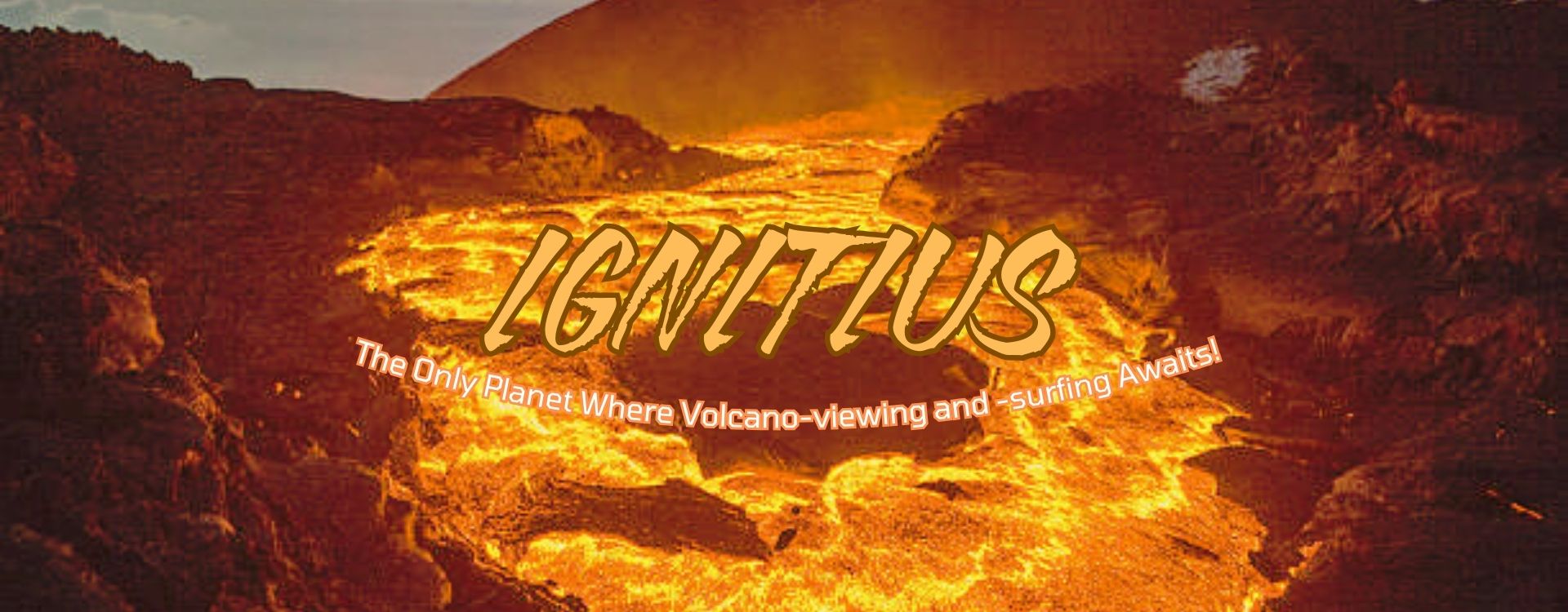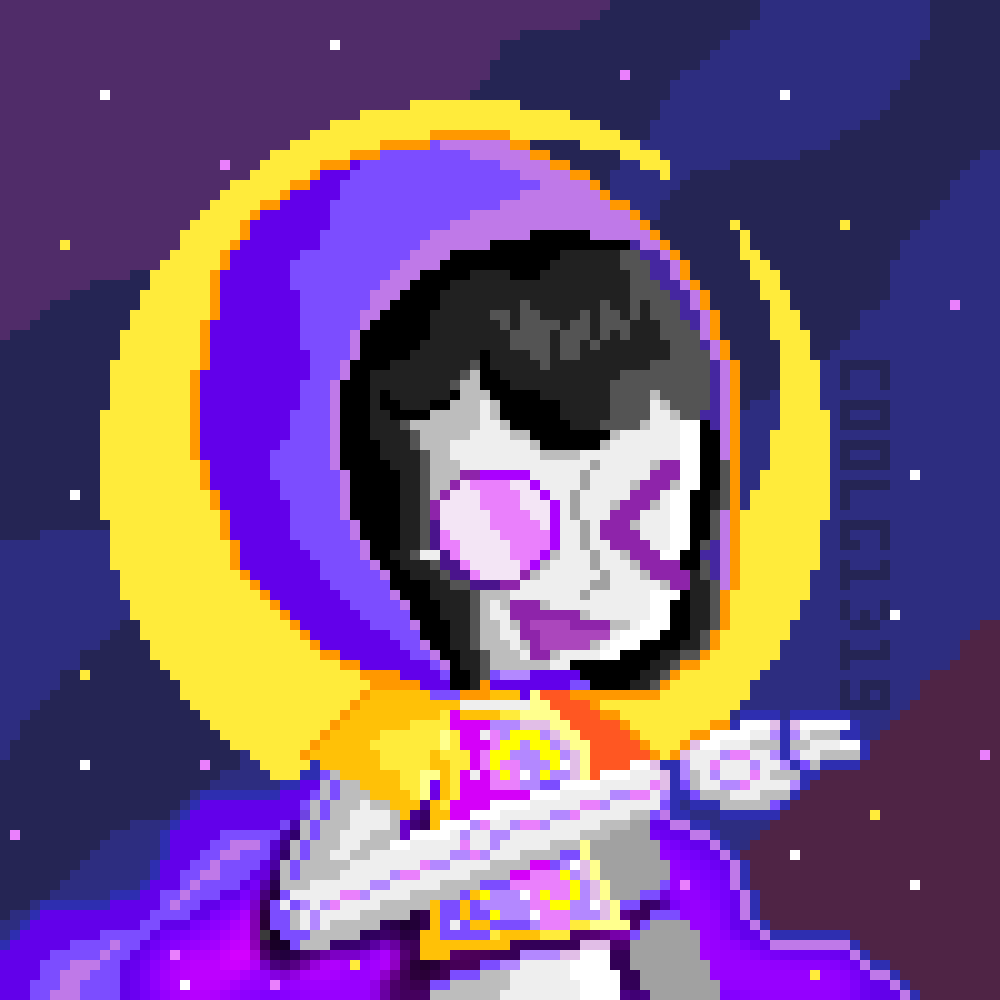Ignitius
What Is This Place?
The second planet from Sol. Ignitius is often called Auxul’s twin due to its similar size and composition. However, its extremely thick atmosphere (it has the thickest in The Sol System!) traps an ungodly amount of heat, creating surface temperatures hot enough to melt titanium. With its beautiful, bright, swirling lava-like appearance, Ignitius is an object of fascination for many space tourists and remains prominent in our night sky.Physical Features
The planet’s rocky terrain is completely shrouded beneath vast expanses of rivers and oceans of molten lava, creating a surreal and fiery landscape. Ignitius is particularly famous for its most notable lava river, Vesuvi, which elegantly flows around the entire circumference of the planet. This immense lava river not only serves as a defining feature of Ignitius but also contributes to its dynamic geological activity, influencing the planet's surface and atmosphere. The combination of Ignitius' size, volcanic features, and partially concealed rocky surface paints the picture of a world that is both intriguing and formidable in the context of the Sol System.
Geography and Climate
Among the most striking features of this volcanic landscape are the expansive shield volcanoes. These broad, gently sloping formations are crafted by the mild eruptions of low-viscosity lava, allowing it to flow over great distances before solidifying. In contrast, small but steep-sided cinder cones punctuate the landscape, forming as volcanic ash and debris accumulate around the vent during explosive eruptions, creating conical hills that stand out against the backdrop of more massive volcanic structures.
The landscape is also marked by vast calderas—large, bowl-shaped depressions formed after catastrophic eruptions when the ground collapses into the emptied magma chamber below. These calderas serve as reminders of the immense forces at play beneath the surface and often host unique ecosystems within their confines.
Scattered throughout Ignitius, you may find lava lakes—large, molten pools of lava that thrive within craters or depressions, creating surreal landscapes that shimmer with intense heat. Beneath the surface, natural tunnels, known as lava tubes, arise from the flow of lava which drains away, leaving hollow cylindrical passages that provide a glimpse into the subterranean world forged by volcanic activity.
When the lava solidifies, it takes on various striking forms, including expansive basalt plateaus—vast, flat areas made of solidified black basalt that are so large they can even be detected from space. This process of solidification can lead to remarkable geological structures known as columnar jointing. As lava cools and contracts, it naturally fractures into stunning hexagonal columns, creating a visual spectacle of natural architecture.
Thermal activity is another captivating aspect of Ignitius’ geography. Hot springs can be found scattered across the landscape, where groundwater is heated by the volcanic heat below, resulting in vibrant thermal pools that bubble and steam. Fumaroles, or vents in the lava planet's crust, release steam and various gases, illustrating the relentless volcanic activity that persists beneath the surface and offering a glimpse into the volatile nature of Ignitius.
As time continues its relentless march, erosion patterns evolve, revealing additional layers of Ignitius' geography. Scoria, a light and porous volcanic rock, forms during explosive eruptions when lava cools rapidly. Simultaneously, areas of solidified lava exhibit distinct signs of erosion, sculpting unique and complex structures that tell tales of past volcanic fury.
This extraordinary and otherworldly landscape is further defined by its incredibly thick atmosphere, composed predominantly of 99.9% carbon dioxide. This dense air contributes to surface temperatures that soar to an astonishing 1700°F (538°C), creating an environment that is both extreme and fascinating. The combination of these geological and atmospheric features embodies the raw power and complexity of Ignitius, painting a picture of an alien world shaped by volcanic forces that continue to shape its destiny.
Travel Advisory
- When your spacecruiser enters Igmitius' atmosphere, it will dramatically reduce its interior temperature to counter the extreme heat of the atmosphere, so ensure to pack at least two layers of thick, warm clothes and perhaps a hot drink to stay warm.
- Flying amongst several active volcanoes is a recipe for substantial turbulence. The moment you hear the turbulence warning, set down any hot food or beverage you have, quickly make your way to the nearest Safety Seats!™ and strap yourself in. If you are with children between 0 and 12 years, either set them on your lap and fasten the belts across your chests or activate the Mini Safety Seats!™ by pressing a button near the bottom of the larger seat and strap the kids in.
- The following precautions must be taken when stepping foot on the planet's surface. (Note: one must be at least 18 years of age and in tip-top shape and have no health-related issues to be allowed to step foot on a planet)
- Strap Yourself with Protective Gear: When venturing into areas with extreme temperatures and sharp volcanic rocks, it is essential to wear heat-resistant clothing and sturdy boots. These protective garments will help safeguard you from high heat exposure and potential injuries from rough terrain.
- Stay Hydrated: It's essential to bring an adequate supply of water, as the environment can be challenging and may lead to dehydration. Staying hydrated is crucial for your well-being in such conditions.
- Enjoy the Sick Lava Flows - From A Distance: It is important to maintain a safe distance from active lava flows to minimize the risk of burns or injuries.
- Look Out for Gas Emissions: Be vigilant about the presence of volcanic gases, as they can be harmful to health. It is advisable to use gas masks when necessary to ensure safety.
- Better Listen to Your Tour Guide - They Know Best: It is important to follow any regulations or guidelines established by tour guides in order to ensure your safety during the tour.
- Teamwork Makes the Dream Work - And Keeps You Safe: When engaging in exploration activities, it is important to do so in groups to enhance safety. This practice ensures that assistance is readily available in case of emergencies.
- Read up on Emergency Procedures - They May Be Boring but Will Be Worth It: It is important to familiarize yourself with evacuation routes, emergency contact numbers, and the locations of safe houses in the event of volcanic activity. Understanding these key components can significantly enhance your safety and preparedness during an eruption.
- Familiarize Yourself with that Map Software You Barely Use: Utilize location tracking and mapping software specifically designed for volcanic terrains to navigate safely and prevent getting lost.
Planetary Classification
Physical Characteristics
Orbital Characteristics
Other Characteristics
Fun Facts!
- Ignitius spins clockwise on its axis while the other eight planets in the Sol System, except Posendi, rotates anti-clockwise! This occurs because, millions of years ago, Ignitius was struck by a large celestial body, knocking it so far off its original position that it is now upside down!
- If you have not noticed while reading about this planet, its orbital day is longer than its orbital year! This happens because the planet spins slower on it own axis than on its orbit around the Sun.
- Ignitius is hotter then Hermani despite the latter planet being closer to the Sun. Why? This is because Ignitius' extremely thick, almost-entirely carbon dioxide atmosphere traps a stupendous amount of heat from the Sun, driving up its surface temperature.
- The first satellite to properly capture these gorgeous images of the rocky lava planet (without burning up upon entering its atmosphere, that is!) is Maggie IG-26. Its journey took five days and he spent a further four days taking pictures! He survived his trip due to his tungsten body, which withstood the lava planet's high temperature.
- The rocky lava planet's largest volcano, Areds, erupts once every two hundred years. When it does, it spews a jet of lava so tall it can be seen for space!
- Did you know you can actually surf on the planet's lava? Now you do! Volcano-surfing is a very popular tourist activity where - if you couldn't guess - people ride down tall lava flows on specialized hoverboards, mainly to compete with each other. If this piques your interest, grab your hoverboard, hop on the next space cruiser to Ignitius and challenge your friends to a friendly match to see who can surf the fastest and the best!
















Love the mix of advertisement, hard data, fun facts and safety protocols. Makes it feel like a real thing!
Thank you! Glad to know that hours of research paid off ^^